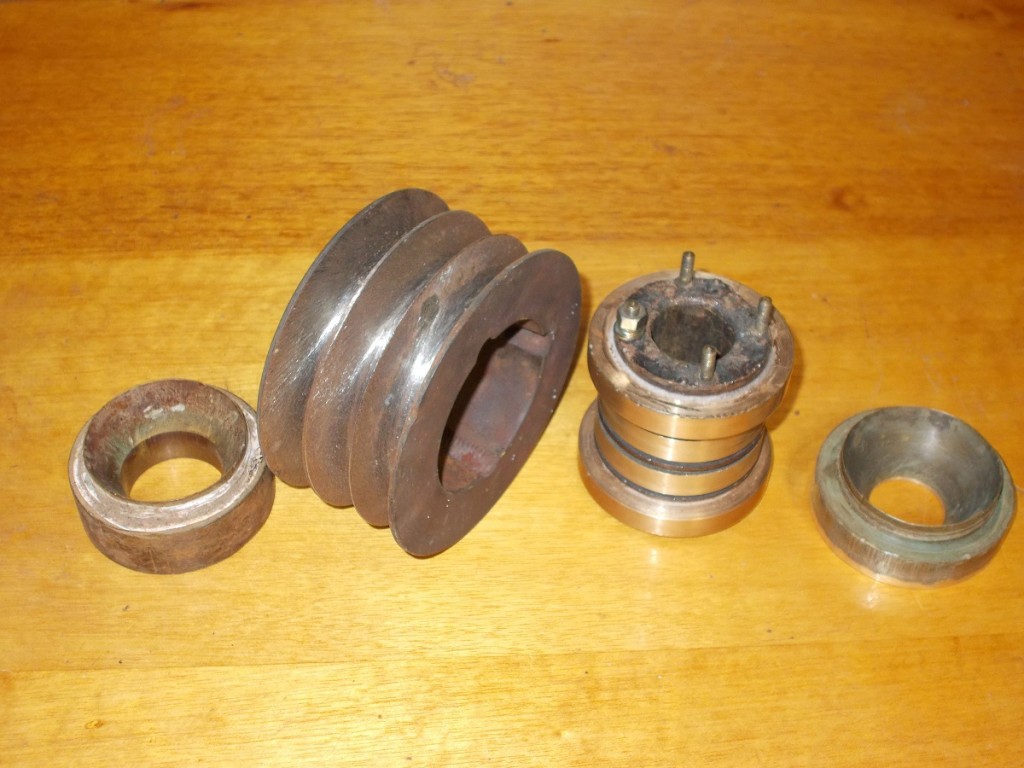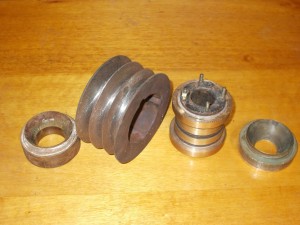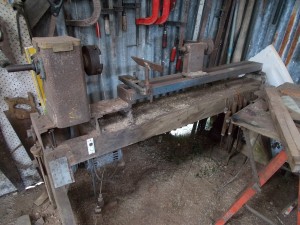
Following my recent blog “How to Weld”, on the realities of welding when you’ve never been taught, haven’t got a clue and have dodgy equipment, I thought I’d offer a few insights into metal lathe-work.
First thing to note is that a metal lathe is finely engineered, geared movement of the tool for smooth cutting, with many automatic features for thread cutting etc, has a tool-post graduated to fractions of a millimetre, is substantially built to close tolerances, and is expensive with an average lathe costing thousands. A wood lathe on the other hand just rotates the wood and has a tool-rest where the tool is hand held and controlled. Its greatest virtue is that it is cheap. I got my wood lathe from a second-hand store for $50 I think. No mount and no motor. From another second-hand shop I got an old washing-machine motor for $20 and I built a substantial trestle of wood to mount the lathe. The main tool used for the mount was a chain-saw and I rather like that rough-hewn look.
One of the great (and scary) features of a wood lathe, is that it has a built-in instruction manual. Not that it has detailed procedures engraved on it, no of course not. It’s just that if you do anything wrong, it throws the tool or the wood at you , and sometimes both. After you have sought medical attention and repaired the equipment, it is unlikely you will repeat that mistake. Instead you will find another mistake until you exhaust your repertoire of blunders, and your medical supplies. Pain aversion therapy really focuses the mind.
Turning metal on a wood lathe has added challenges, and should only be attempted if you have personal protection wear obtained from the bomb squad. Having got that disclaimer out of the way, of course I didn’t. I just blundered in wearing singlet and thongs. For any reader in the northern hemisphere, thongs are rudimentary footwear. Wouldn’t want you to get the wrong impression.
First of all, put away any wood cutting tools. You won’t have streams of shavings streaming over your shoulder, you’ll have mangled metal, blood and bone in under half a second. The only tools to use are scrapers, drills, grinders, abrasives and hacksaws. If you are turning steel or harder materials, don’t use scrapers. For brass, aluminium etc, scrapers will work fine, but need frequent sharpening. My scrapers are made from old worn out files.
In the picture above, the pulley wheel was refurbished after about 5 years of service, as the ‘v’ grooves wear to ‘u’ grooves and lose grip. The angle grinder was steadied on the tool-post and a little cut-out of plywood used to check the angle. The pulley is good for a few more years now.
The nozzles were turned from a 3 inch diameter bar of brass with drill mounted in the tail-stock and scrapers, and I have a few different sizes to allow for seasonal flow rates in the creek.
The slip rings assembly has been refurbished after rings 1 and 4 burnt out when they started sparking, which quickly erodes the rings. I found I had some spare metal on the end of some nozzles, so cut them off to 9mm thick with a hacksaw on the lathe. It is quite easy to part them off with an accurate thickness. I then bored the holes out with a scraper until I got an interference fit. That means tight, but can bang them on with a hammer. A bit of superglue for good luck and whack it together. The slip rings currently on the generator have been going about 7 years and were made from scratch. 1 inch shaft (yes, ancient machine and ancient units), so I started with 1 inch poly pipe for insulation. The rings were turned from the 3 inch brass bar and the insulation between them was rings of laminex I had come by when my mother upgraded her shower. Some internal wiring and bolts for terminals were all clamped together with construction glue.
I think I have explored every possible way of having the brushes sparking in the 30 plus years it has been in continuous operation. The brushes wear out, the springs pushing them onto the rings rust away or break, the rear bearing is worn and though no discernible vibration can be seen or felt but causes the brushes to bounce and spark. The last problem following its most recent dumping in the creek during a cyclone, was hard to diagnose. 30 years and 24,440,400,000 rotations later, had caused the rotor to have about 4mm of end-play. That is the rotor could flop back and forth and move the rings off the brushes. I used a couple of old piston rings to take up the slack.
If you ever need a generator to do hard and continuous service, do yourself a favour and get a brushless one.
In case you didn’t know, I like bodging. Fixing things with whatever is at hand, reusing discarded resources and not consuming future supplies. It is easy to fix things with a cheque book. Open your wallet and get an expert. It is satisfying to use tools and junk to get what you need. It is empowering to acquire skills and become less dependant on the ‘system’. Not to mention hugely cheaper. In my travels in Africa, I can assure you the craft of ‘bodging’ is alive and well with many clever and skilful practitioners. Alas, the people of the more developed countries have become more and more dependant on other people to fix a problem. Avagoyamug!


From one “Bodger” to another, well-done Paul. My old lathe was driven by a canvas 4 inch wide belt. With a 3 ft. throw radius and 4 jaw chuck. Ten foot bed. We made excavator buckets on it. (Along with a 1/4″ steel metal break and laser cutter) Sounds impressive, but that old lathe only cost $1000. and was dragged out of a 90 year old logging mill at Lake Cowichan BC. Your blog brings back such memories.
Martin can testify to the lathe if he can remember it. Your friend, monte.